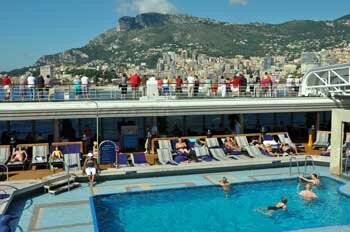A Classic Med Cruise
Aboard Nieuw Amsterdam
By Robert W. Bone
 SAILING IN THE MEDITERRANEAN: I confess to being a little nervous as our ship approached the Strait of Messina, that strip of water between the toe of Italy’s boot and the large island of Sicily. That narrow gap was where Odysseus, the ancient mariner of the Mediterranean, was forced to navigate carefully between Scylla and Charybdis. If you remember your Odyssey, Scylla was a six-headed creature who occupied a cliff on one side of the two-mile-wide channel and Charybdis was a monstrous whirlpool stirring up trouble along the opposite bank.
SAILING IN THE MEDITERRANEAN: I confess to being a little nervous as our ship approached the Strait of Messina, that strip of water between the toe of Italy’s boot and the large island of Sicily. That narrow gap was where Odysseus, the ancient mariner of the Mediterranean, was forced to navigate carefully between Scylla and Charybdis. If you remember your Odyssey, Scylla was a six-headed creature who occupied a cliff on one side of the two-mile-wide channel and Charybdis was a monstrous whirlpool stirring up trouble along the opposite bank.
According to Homer, Odysseus’ ship managed to skirt Charybdis and then scoot through the channel intact. Never mind that he did lose a half-dozen members of his crew in the process— one sailor each to feed the six mouths of Scylla.
Our own passage through the strait was smooth and uneventful. No monster appeared, and although there is a large whirlpool still indicated on modern sea charts, the 86,000-ton Nieuw Amsterdam, flagship of Holland-America cruises, was up to the task. All of our 2,000 passengers and 1000 crew members, and the elegant, black-hulled ship itself, survived intact.
This was symbolic of the cool efficiency of our entire 12-day Mediterranean voyage which began in the exciting Spanish metropolis of Barcelona. It finished in Venice, the canals and walkways of which appear pretty much the same today as they did when Canaletto painted and Casanova dallied there centuries ago.
The Nieuw Amsterdam’s itinerary was an all-dessert cruise. Each day brought forth another sweet and delicious port, each of which could easily absorb a week-long meal of intellectual exploration and contemplation. This was not a cruise for those who would rather study each destination in detail. Neither was it one for those who like long, languorous days at sea. In fact, the ship offered just one sea day to relieve all the multiport activity.
After Barcelona, the stops on our schedule were, in order of march, Monaco (always a safe bet), Livorno (for easy access to either Florence, Pisa, or Siena), Civitavecchia (the port for Rome), and Messina (a major city on Sicily).
 |
| Nieuw Amsterdam Visits The Riviera |
Following that breather day at sea, the activity resumed with three Greek ports, Nafplion (gateway to the ruins of Corinth and Mycenae), Katakolon (for access to ancient Olympia, site of the ancient games), and then paused at the charming Greek island of Corfu. After that, the ship made a port call at the walled city of Dubrovnik, Croatia, often called the “Pearl of the Adriatic,” before sailing smack into downtown Venice.
Cruisers who choose a ship-sponsored shore excursion at every port might easily plunk down an extra grand or more. For my money, the most interesting excursion on our cruise was Olympia. This was the site of the Ancient Olympics—the famous contests between Greek city-states which were held annually from 776 BC to 394 AD – an impressive 1,170-year run.
Another eye-opener was the hydrofoil tour from Corfu to Saranda, Albania, even if some aspects of it were a little disheartening. Although it has been 20 years since that former Communist country was re-opened to the outside world, it still seemed to have a sort of hang-dog look about it. Skeletons of unfinished buildings testified to unrequited real estate speculation and commercial ambitions which have not yet come to pass.
Our Albanian guide, Loretta, pointed out several military pill boxes dotted here and there: “For years we were told to be ready for an invasion, but nobody knew by whom or from where,” she said. “And it never came.”
Returning to visually delightful Corfu for a brief respite as part of the same tour was a welcome relief.
The Nieuw Amsterdam is Holland-America’s newest cruise ship (launched 2010), and I think just the right size. Carrying about 2,000 passengers, it is large enough to be elegant and have all modern amenities, but not so large to as to seem crowded, unlike some competitors which now carry as many as 4,000 or so.
Tasteful interior decoration honors the history of New York City which was known as “Nieuw Amsterdam” when founded by the Dutch in the 18th century. Some unusual artwork is made up of tiny patches of photographs pasted together to form streets and skyscrapers. Holland America has its own history serving passengers between Europe and from New York since the 19thcentury.
In the center of the ship a large atrium is highlighted by a majestic telescoping chandelier which also evokes New York City’s iconic skyline, regularly changing colors. Old photographs of the city displayed in many parts of the ship help continue the Manhattan theme.
While the Nieuw Amsterdam has the requisite number of tasteful restaurants, bars, pools, a spa, and entertainment venues, it does not sport the more brassy features of some larger vessels with things like rock walls and tube slides. Dress is generally casual, although there are three formal dinner nights.
Guests familiar with other Holland-America vessels will find their way around easily. Like others in the fleet, it features the Pinnacle Grill, an exclusive, reservations-only dining room (extra fee) separate from the main Manhattan Dining Room, where the meals are included in the fare. My experiences in both were more than satisfactory.
The staterooms also blend historic and modern decorative elements, some with original art painted by some modern 21st century Dutch masters. Another plus: Most staterooms have balconies . And that’s a wonderful way to witness sailing into some of Europe’s most wonderful ports while still wearing your pajamas.
If you go: Holland-America’s website is at hollandamerica.com, and phone is (877) 932-4259.
Holland-America also offers shorter, 7-day Mediterranean cruises and longer, 24-day itineraries.
Robert W. Bone lives near San Francisco. He has been covering cruises and other travel subjects for more than half a century. More of his Nieuw Amsterdam photos may be seen at robertbone.com/medcruise.
More from CruiseDiva.com:
Articles & Advice
Cruise Reviews
Cruise Line Profiles
